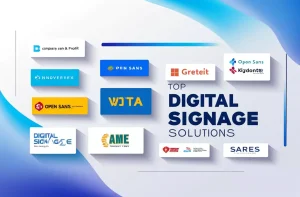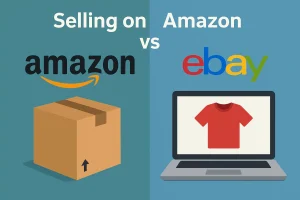Steps to Launch Your Digital Products Business and Earn While You Sleep
7 Proven Steps to Launch Your Digital Products Business and Earn While You Sleep
Are you tired of trading time for money? What if you could package your expertise into a product once—and sell it over and over again with zero overhead? That’s the power of digital products. Launching a digital products business in 2025 is a smart, scalable way to achieve financial independence and passive earnings—far more than just a passing trend.
Whether you’re a freelancer, coach, content creator, or expert in any niche, digital products allow you to stop chasing clients and start building assets that work for you. Your earning potential is limitless, as are the options available to you, ranging from membership sites and online courses to ebooks and templates.
Discover the 7 proven steps to start your digital products business from scratch. These are actionable strategies that top creators use to validate, launch, and grow their income online—without complex tech, big budgets, or burnout.

Build Freedom Through Digital Products
In today’s fast-paced world, the most successful entrepreneurs don’t rely on inventory, staff, or traditional overhead—they monetize what they already know. The key to generating leveraged revenue and real lifestyle freedom is digital products.
Picture this: waking up to sales notifications on your phone, knowing that your knowledge is being downloaded, used, and appreciated—all while you were sleeping. Don’t need shipping labels. No client calls. No hourly commitments. Just scalable, evergreen assets that grow your income while freeing up your time.
This isn’t a pipe dream. It’s a proven model for coaches, consultants, freelancers, and creatives who are ready to transition from trading hours for dollars to building something that compounds. Whether you’re teaching photography, organizing finances, coaching writers, or helping businesses grow—your unique knowledge can be transformed into value-packed digital products people are eager to buy.
No fluff. No overwhelm. Just a clear, smart path to building your own digital product business that earns while you sleep.
Identify a Profitable Problem to Solve
Every successful digital product starts with one simple foundation: solving a specific problem that real people are already struggling with. Too often, aspiring creators get stuck building something they think people need—only to launch to silence. The key is to focus on demand, not guesswork.
Identify a Profitable Problem to Solve
Solving a specific problem that real people are already struggling with.
The key is to focus on demand, not guesswork.
Start with Research, Not Ideas
Before you even sketch out a product outline, spend time exploring where your ideal audience hangs out and what they’re already asking for. This is where gold lives:
- Reddit, Quora, and Niche Forums: Search for threads where people rant, ask for help, or share frustrations. Take note of repeated questions and emotional pain points.
- Facebook Groups & Discord Channels: Join groups in your niche. Look for posts that get high engagement—especially those with people venting about struggles or asking for step-by-step help.
- Your Own Inbox & DMs: Have people asked you the same question more than once? What do friends or followers come to you for? These “repetitions” often point to your most valuable expertise.
Look for Problems That Are:
- Urgent: People are actively seeking a solution now.
- Recurring: It’s not a one-time annoyance, but an ongoing frustration.
- Costly: It wastes time, money, or causes stress—and people will gladly pay to solve it.
- Unsolved (or Poorly Solved): Existing solutions are too complicated, expensive, or ineffective.
Ask Yourself:
- What do I know that others struggle with?
- What shortcut, system, or framework could save someone hours of frustration?
- Can I deliver a transformation, not just information?
Real-World Example:
Let’s say you’re a freelance designer. You notice people in startup groups constantly ask for pitch deck templates or brand kits. That’s a pain point. Instead of creating a broad design course, you could offer a Startup Pitch Deck Template Bundle that helps founders present confidently to investors—without hiring a designer.
That’s how you create a problem-solving product people are hungry for.
Create a Simple, Valuable Product
Once you’ve identified a clear problem your audience wants solved, it’s time to create a digital product that delivers a fast, focused solution. But here’s the truth: your first product doesn’t need to be big—it needs to be useful.
Truly innovative digital products prioritize simplicity over complexity. Think quick win. Your goal is to help someone go from problem to result with as little friction as possible.

Start Small, Think Specific
Your product should solve one specific problem for one specific type of person. That level of focus makes your product easier to build—and easier to sell. It removes decision fatigue for the buyer, and overwhelm for you as the creator.
Instead of building a massive online course or 300-page ebook, start with something lean and powerful. Solve one urgent problem well, and you instantly become more valuable.
Proven Product Types That Work
Here are simple formats that top creators use to launch fast:
- Templates & Checklists: Done-for-you tools that save time. Think: checklists for content audits, pitch deck templates, and social media calendars.
- Mini Courses or Workshops: Short, outcome-focused lessons (30–90 minutes) that teach a skill or solve a challenge. Ideal for selling at $19–$99.
- Ebooks & Action Guides: 20–50 pages is plenty if it’s clear, actionable, and gets the reader to a result.
- Swipe Files & Frameworks: Collections of scripts, email sequences, or frameworks people can customize and use immediately.
- Toolkits or Bundles: Combine multiple quick-win resources into a high-value package.

These formats are not only easier to produce—they’re also easier for your audience to consume and apply quickly, which boosts satisfaction and referrals.
Speed to Market > Perfection
Done is better than perfect. Launching a simple product in 30 days is infinitely more powerful than planning a complex one for 6 months and never finishing it.
- Use tools like Canva, Notion, Google Docs, or Loom to create your product fast.
- Focus on solving, not styling. Clean, usable, and clear beats pretty-but-confusing.
You can always upgrade later based on customer feedback. But what if the product doesn’t exist?
Don’t aim for perfection—aim for progress. Your initial digital product serves as validation of your idea. Make it small, smart, and laser-focused on a result your audience actually wants. Launch fast, learn fast, and build from there.
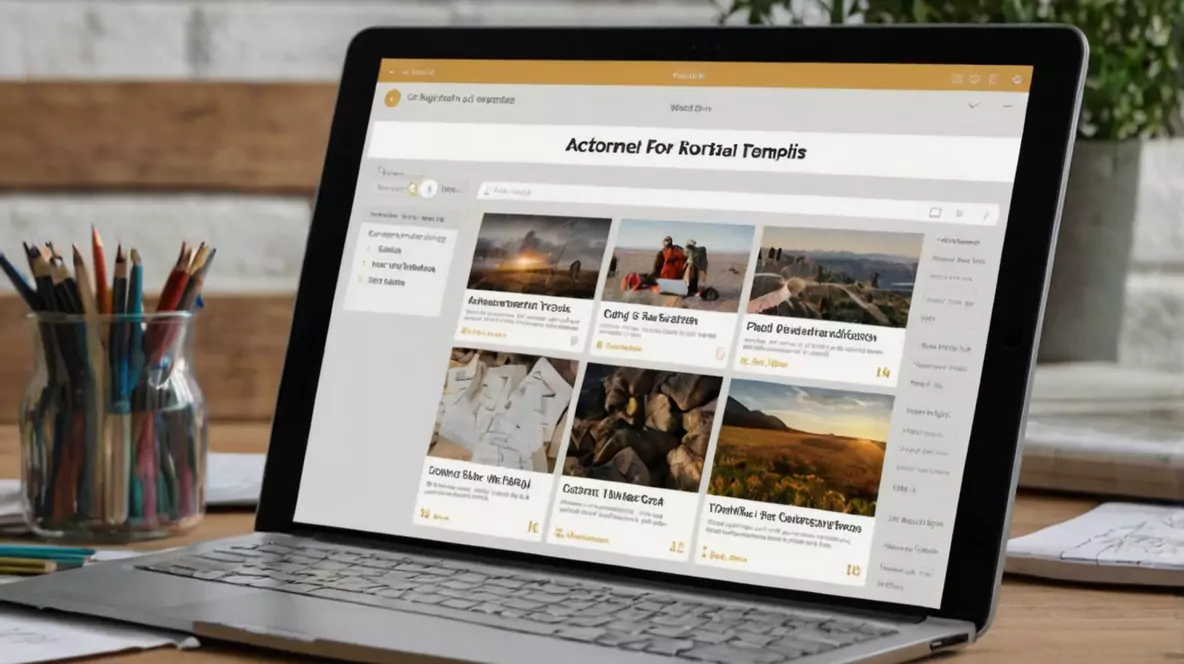
Use Tools That Automate Everything
Scalability is one of the biggest perks of a digital product business. But to truly scale without burning out, you need to leverage automation from day one. The right tools allow you to sell, deliver, and nurture your audience—even while you sleep.
Instead of manually sending files or chasing payments, you can use smart platforms to handle the heavy lifting—freeing you up to focus on growth, not admin.
Your Essential Tech Stack for Passive Sales

Let’s break down the key categories of tools you’ll need—and trusted platforms that make automation effortless:
- Digital Product Delivery Platforms
These are your storefronts. They host your product, process payments, and automatically send your buyers what they purchased—without you lifting a finger.
- Gumroad – Perfect for creators selling ebooks, templates, or single-file downloads. Simple, low-friction checkout.
- Podia / Kajabi – Best for course creators and those offering memberships, workshops, or coaching bundles.
- Payhip – Great for selling directly with coupons, upsells, and a user-friendly checkout experience.
Tip: Look for platforms that support instant access, handle taxes/VAT, and allow upsells or affiliate programs.
- Email Marketing & Automation Tools
Email is your most powerful asset for nurturing leads, onboarding customers, and driving repeat sales.
- ConvertKit – Built for creators, offering landing pages, automations, and segmentation.
- MailerLite – Affordable, beginner-friendly, and includes automation and landing pages.
- Flodesk – Visually stunning emails and simple workflows, great for lifestyle brands.
Use email to send:
- Welcome sequences for new customers
- Lead magnet delivery for growing your list
- Product launches, promos, and updates
- Automated check-ins to drive engagement
- Checkout & Payment Optimization
A smooth checkout process = higher conversion rates. Optimize payment flows for a smoother purchasing experience.
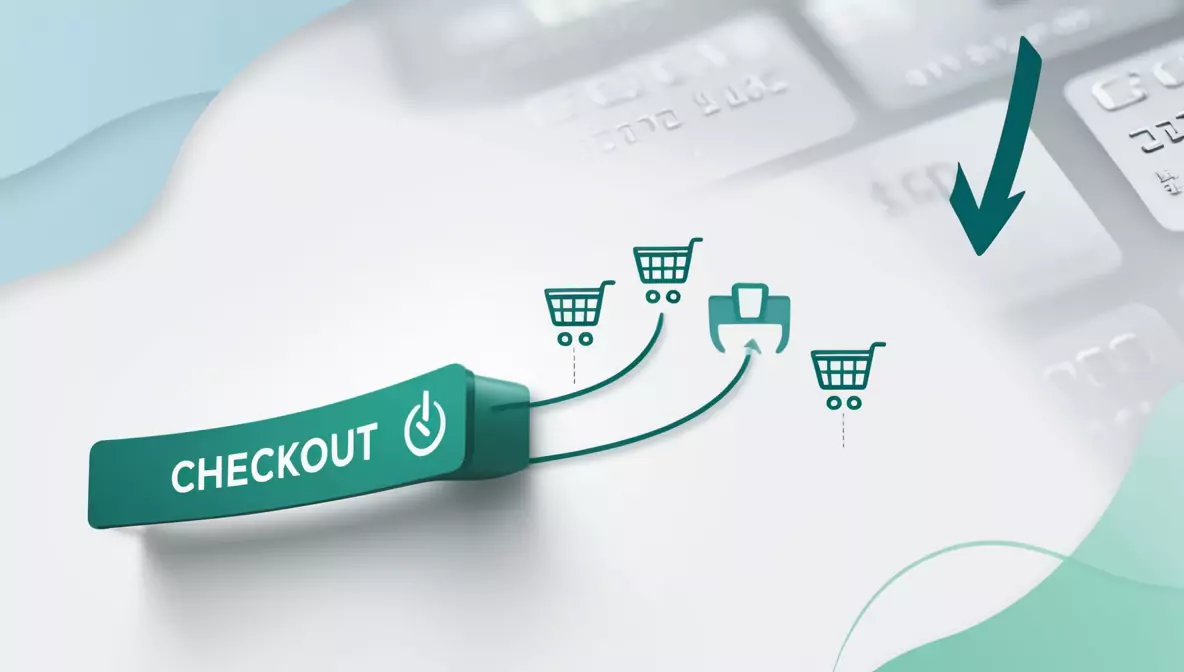
- ThriveCart – Optimized for sales funnels, upsells, A/B testing, and high-converting checkouts.
- Stripe + WooCommerce – If you want full control and run a WordPress site.
Pro tip: Add one-click upsells or order bumps to increase average order value without extra marketing.
- Content Hosting & Learning Management Systems (LMS)
If you’re selling courses, coaching, or downloadable lessons, use platforms designed for seamless student experiences.
- Teachable / Thinkific – Drag-and-drop course builders with built-in sales pages and student progress tracking.
- Notion (for low-cost options) – Ideal for selling guides, systems, or templates in a beautiful, user-friendly layout.
Why Automation = Freedom
Automating your backend does more than save time. It creates a professional, polished customer experience that builds trust and scales with you.
Instead of asking:
“How can I hustle harder to sell more?”
Ask:
“How can I design a system that sells, delivers, and follows up without me?”
AI-powered tools turn your digital offering into a hands-free revenue source. Use the right tools to automate sales, delivery, and engagement—so you can work less, earn more, and focus on creating even more value.
Build an Experience, Not Just a Product
Selling a digital product isn’t just about delivering a file—it’s about creating an experience that makes your customers feel seen, supported, and successful. In a crowded marketplace, your product is only the beginning. The way it’s delivered, onboarded, and followed up on is what sets you apart.

People don’t just want content—they want clarity, confidence, and results. If your product helps them feel empowered and taken care of, they’ll remember your brand, return for more, and tell others about it.
Why Experience Matters More Than Ever
- First impressions stick. The moment someone buys from you, they’re asking, “Was this worth it?”
- User confusion kills trust. If your buyer doesn’t know what to do next, they’re more likely to refund—or never use your product.
- Delight = retention. A thoughtful customer experience turns one-time buyers into lifelong fans.
Key Elements of a High-Value Customer Experience
You don’t need fancy tech or a giant team—just a few intentional touchpoints to make your product feel premium:
1. A Warm, Clear Welcome Email
- Thank them for buying.
- Reinforce the value they’ve just unlocked.
- Include easy instructions or a “Start Here” section.
- Bonus: Add a personal video or gif for a human touch.
2. Guided Onboarding (Even for Simple Products)
- Break down how to use the product step by step.
- Offer a checklist, video walkthrough, or mini tutorial.
- Help them get their first win fast—within minutes of download or access.
3. Follow-Up Emails That Add Value
- Send a check-in email 2–3 days later: “How’s it going?”
- Offer bonus tips, FAQs, or a companion resource.
- Encourage input to foster dialogue and demonstrate your commitment.

Go the Extra Mile
These little things have a big impact:
- Add a surprise bonus inside your product.
- Create a private community or invite them to join your newsletter.
- Encourage sharing: offer a discount or freebie for referrals.
People don’t remember “meh” transactions—they remember exceptional experiences. Satisfied and well-cared-for customers often become a company’s greatest ambassadors.
A PDF is just a product. But a smooth, thoughtful, value-rich customer journey? That’s a brand. Don’t just deliver content—deliver confidence. Build trust, spark transformation, and make your buyers feel like VIPs.
Price Based on Outcome, Not Time
When it comes to digital products, pricing isn’t about how long it took you to create something—it’s about the transformation your product delivers. People don’t pay for PDFs or videos. They pay to solve a problem, reach a goal, or avoid pain. That means your price should reflect the outcome, not the effort.
This is called value-based pricing, and it’s one of the most powerful mental shifts you can make as a digital product creator.

Why Most Creators Undervalue Their Products
Often, new salespeople make the mistake of believing:
“It only took me a few hours to make, so I shouldn’t charge much.”
But that’s the wrong lens. The real question is:
“How much time, money, stress, or frustration does this save someone?”
Think like this: a $29 checklist that saves a business owner 5 hours a week is more valuable than a $300 course that’s hard to implement.
People will gladly pay for speed, clarity, simplicity, and results—especially if you help them avoid trial-and-error.
How to Price for Outcomes
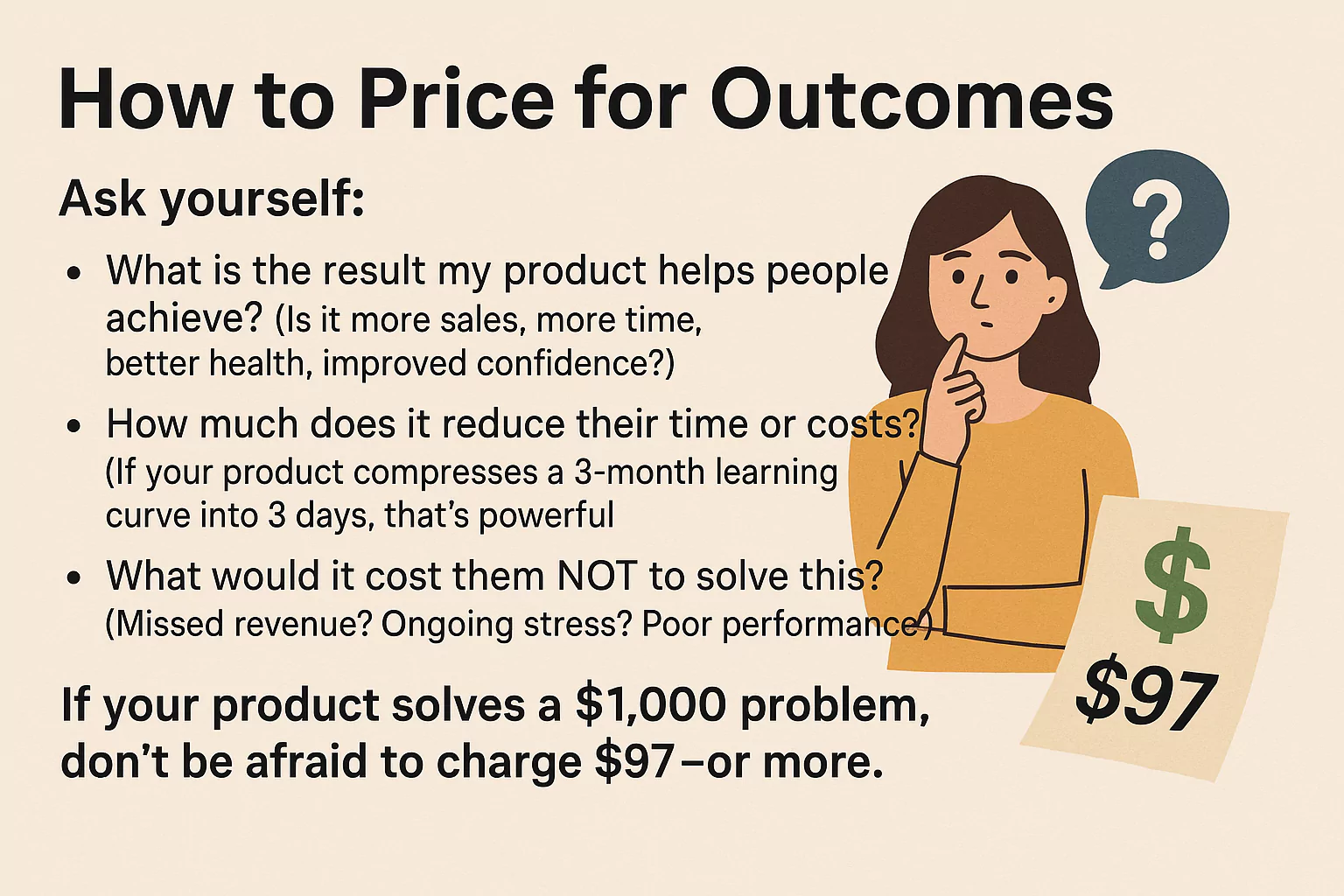
Ask yourself:
- What is the result my product helps people achieve?
- Is it more sales, more time, better health, improved confidence?
- How much does it reduce their time or costs?
- If your product compresses a 3-month learning curve into 3 days, that’s powerful.
- What would it cost them NOT to solve this?
- Missed revenue? Ongoing stress? Poor performance?
If your product solves a $1,000 problem, don’t be afraid to charge $97—or more.
Anchor Pricing With Context
Help customers understand the value:
- Use testimonials or beta feedback that show real-world outcomes.
- Compare the cost of alternatives: “Hiring a consultant would cost $500+, this framework is just $49.”
- Show ROI visually with infographics, case studies, or even hypothetical scenarios.
Example: “This $39 content planner helped a solopreneur double their email engagement in 2 weeks.”
Tiered Pricing (Optional But Powerful)
Want to serve more buyers at different levels? Offer tiered versions:
- Basic: Just the template or tool.
- Standard: Includes walkthroughs, bonus tips.
- Premium: includes community access, coaching, or feedback.
This not only increases conversions—it lets serious buyers invest more.
Price your product based on the value it creates, not the hours it took to build. When you price with confidence, customers feel confident too. Remember: your knowledge is someone else’s shortcut—and shortcuts are worth paying for.
Grow with One Platform First
When you’re starting out with digital products, it’s easy to fall into the trap of “be everywhere, post everything, talk to everyone.” But trying to master every social media platform at once will drain your time, energy, and creativity.

The smarter path? Pick one platform, go all in, and dominate your niche there first.
By focusing your energy on a single channel where your ideal buyer already hangs out, you can build trust faster, grow your audience more effectively, and create content that actually converts—without burning out.
The Power of Starting with Just One Platform
Here’s what happens when you spread yourself too thin:
- You post inconsistently and get no traction.
- Your message becomes diluted across different audiences.
- You end up spending more time creating than connecting.
When you dedicate yourself to one platform and interact with it purposefully, you:
- Build real community.
- Learn what resonates (and sells).
- Grow faster with less effort.
Focused energy creates momentum.
How to Choose the Right Platform
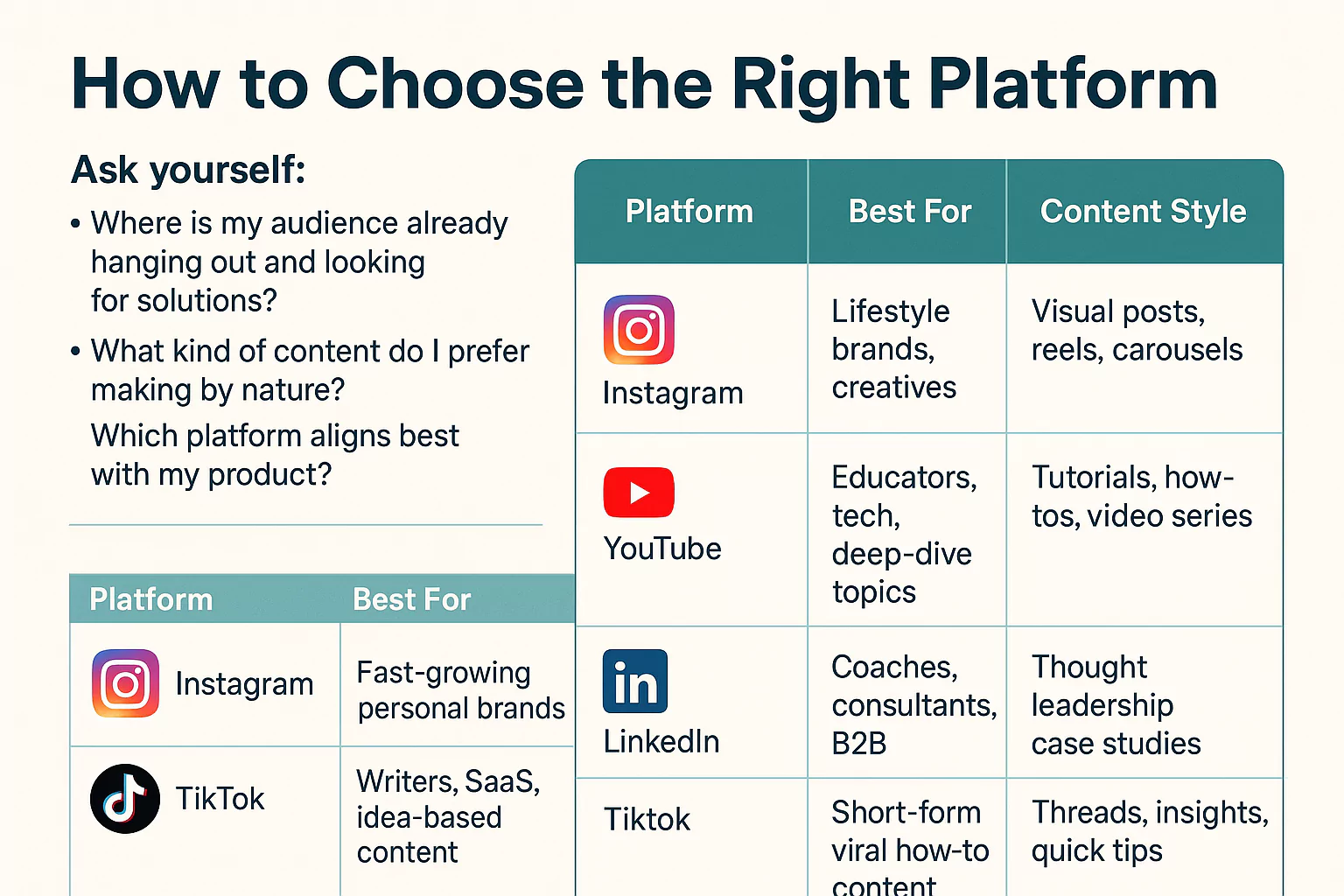
Ask yourself:
- Where is my audience already hanging out and looking for solutions?
- What kind of content do I prefer making by nature?
- Which platform aligns best with my product?
Platform | Best For | Content Style |
Lifestyle brands, creatives | Visual posts, reels, carousels | |
YouTube | Educators, tech, deep-dive topics | Tutorials, how-tos, video series |
Coaches, consultants, B2B | Thought leadership, case studies | |
TikTok | Fast-growing personal brands | Short-form, viral how-to content |
Twitter/X | Writers, SaaS, idea-based content | Threads, insights, quick tips |
Choose one based on where your buyers already spend their attention and what content you can sustainably create.
The “Go Deep” Growth Strategy
Once you’ve picked your platform, do this:
- Show up consistently.
- Post 3–5 times per week minimum. Frequency builds familiarity.
- Post 3–5 times per week minimum. Frequency builds familiarity.
- Give away value freely.
- Share bite-sized solutions, tips, and behind-the-scenes content.
- Share bite-sized solutions, tips, and behind-the-scenes content.
- Tease your product often.
- Position it as the shortcut, the system, or the result they want.
- Position it as the shortcut, the system, or the result they want.
Pro Tip: Use the 80/20 rule. A strong content strategy focuses primarily on establishing trust—through value, education, and relatability—with about 80% of your material. The remaining 20% can be dedicated to direct promotional messaging.
Turn Attention into Sales

Don’t just post—convert.
- Have a clear call-to-action (CTA) in your bio or pinned content: link to your product, freebie, or waitlist.
- Use a lead magnet (like a free checklist or mini-course) to grow your email list.
- Start conversations in DMs and comments—they’re gold mines for feedback and early buyers.
Burnout is inevitable if you try to become proficient on every platform. Instead, master one channel where your buyers live, go deep, and let your consistency build momentum. When you nail one platform, your audience—and your sales—will grow naturally.
Validate Before You Build Big
The #1 mistake digital product creators make?
Spending weeks (or months) building something no one wants to buy.
You don’t need a fancy website, perfect branding, or a polished product to start selling. What you do need is proof—proof that people actually want what you’re offering, are willing to pay for it, and will see real value in it.

The smartest creators test first and build second. That’s how you launch lean, gather feedback, and avoid costly flops.
What is Product Validation?
Validation means confirming—before you build—whether your idea has real demand.
Ask:
- Will people buy this?
- Will they pay for it now, not “someday”?
- Do they clearly understand the value?
If the answer is yes, you’re not guessing—you’re building a proven offer.
3 Proven Ways to Validate Your Digital Product
You don’t need a massive audience or months of prep. Here’s how to test quickly and effectively:
- Pre-Sell Before You Build
Create a simple sales page with a clear description of the product you’re planning to build.
- Add a checkout button with a future delivery date.
- Offer a discount or bonus for early buyers.
- If people buy, you’ve got proof—and upfront funding.
Works best for: Courses, templates, frameworks, guides.
Example: “Get my 7-day Content Strategy Kit (launching May 30). Pre-order now for 50% off!”
- Run a Beta Test
Invite a small group of people (5–20) to test your product early in exchange for feedback and a discount—or even for free.
- Focus on observing how they use the product.
- Ask what confused them, what excited them, and what’s missing.
- Use their language in your marketing copy later.
Works best for: Workshops, mini-courses, swipe files, new frameworks.
3. Start a Waitlist or Interest Page
Set up a quick landing page with a headline, a short description, and an email opt-in. Use blog entries, direct messages, or social media to increase traffic to it.
- High waitlist sign-ups indicate market interest.
- Ask them a follow-up question: “What’s your biggest challenge with X?”
Bonus: Build hype while you create!
Tools to Help You Validate
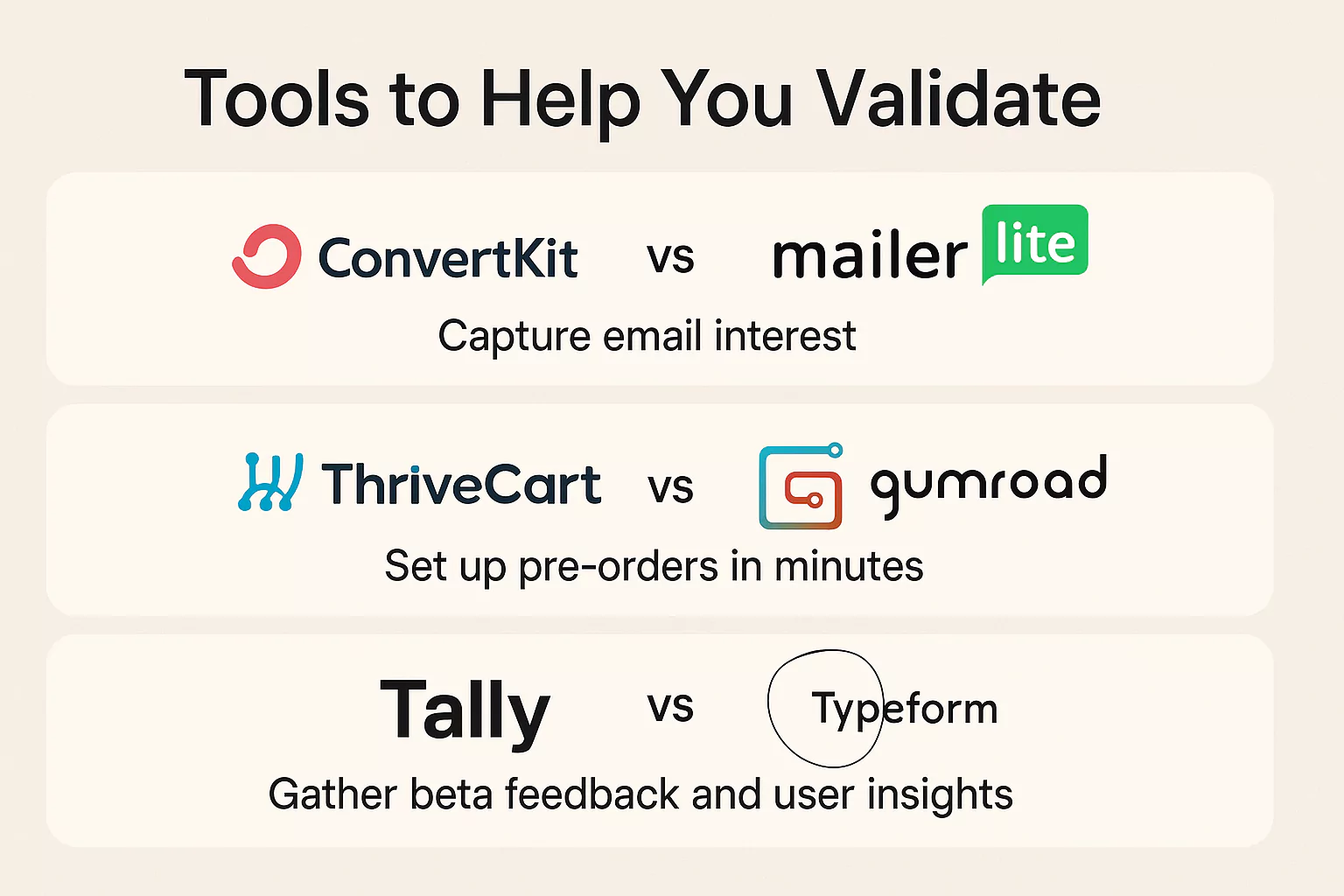
- ConvertKit / MailerLite: Capture email interest.
- ThriveCart / Gumroad: Set up pre-orders in minutes.
- Tally / Typeform: Gather beta feedback and user insights.
What to Watch For
Validation is about real buying behavior—not just compliments.
Don’t count likes or nice DMs as proof.
Only money or clear opt-ins = real validation.
If no one buys or signs up? That’s not failure—it’s feedback. Tweak the offer, clarify the outcome, or reframe the problem you’re solving.
Don’t build blindly. Test your idea, get real feedback, and make sales before you go all in. That way, you’re creating a product people already want—not one you hope they’ll want. Validate early, launch lean, and build better.
Conclusion: Your Journey Starts Now
No advanced tech knowledge, influencer status, or marketing expertise? You can still succeed with digital products.
You need clear vision, a solid plan, and the boldness to begin.
Every six-figure course, viral template pack, or bestselling eBook started the same way:
With someone like you—who decided to stop trading time for money and started packaging what they already know into something scalable.
Let’s Recap Your 7 Proven Steps:
- Identify a Profitable Problem: Real value starts by solving real pain.
- Create a Simple, Valuable Product: Start small, solve one thing well.
- Use Tools That Automate Everything: Let tech work while you sleep.
- Build an Experience, Not Just a Product: Elevate trust and retention.
- Price Based on Outcome, Not Time: Your product is a result, not a file.
- Grow with One Platform First: Go deep, not wide—build loyal fans.
- Validate Before You Build Big: Test ideas fast. Sell before you scale.
This is your roadmap—not to hustle harder, but to build smarter.
What Happens If You Start Today?
- From concept to market in 30 days or less.
- In just two months, you could be earning money by selling your own digital creations.
- In 6 months, you could be earning income that doesn’t depend on your hours.
Your expertise isn’t just useful—it’s monetizable. Someone out there is searching for what you already know.
Now is the moment to stop waiting for permission, and start building freedom on your terms.
Final Thought
The digital economy is exploding. More people are buying courses, templates, and guides than ever before.
And the ones succeeding aren’t the smartest—they’re the ones who started.
Start messy. Start small. But start.
Progress beats perfection—take the first step.
Ready to Launch Your Digital Product?
Download my Free Digital Product Launch Checklist to stay on track and avoid common mistakes.
Your journey to passive income and digital freedom starts now.
The hardest part is starting—just begin!

